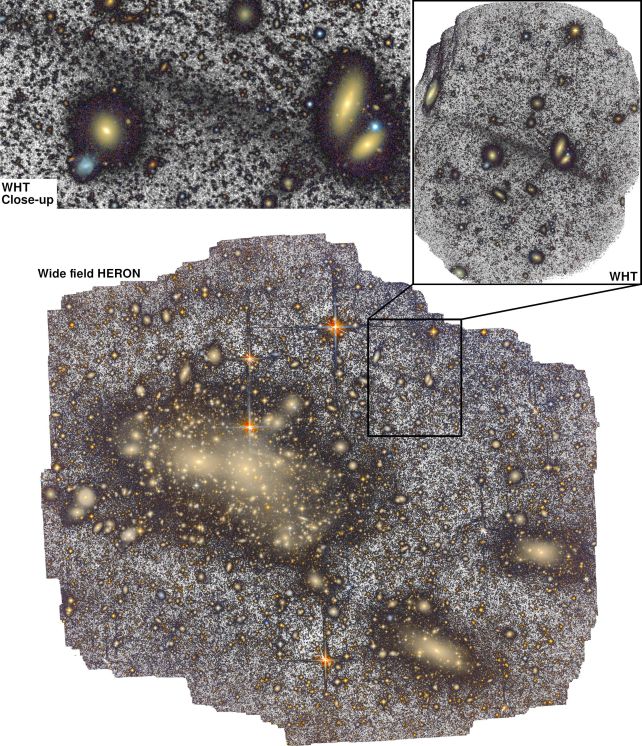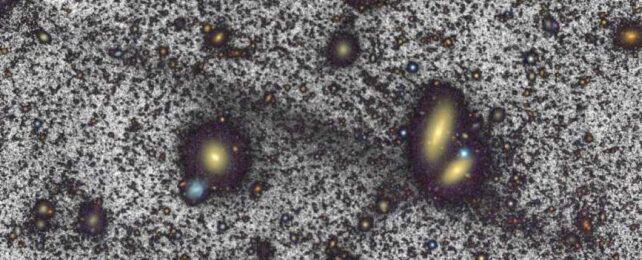A stunning river of stars has been spotted flowing through the intergalactic space in a cluster of galaxies about 300 million light years away.
Such bridges are known as stellar streams; and, at a length of 1.7 million light-years, the newly named Giant Coma Stream is the longest we've ever seen. And that's not all: the faint river is the first of its kind ever seen outside of a galaxy.
The discovery is a huge surprise. In such a dynamic and gravitationally complex environment as a galaxy cluster, something as tenuous as a stellar stream isn't expected to last very long at all.
Yet here we are. The find can be used to study galaxy clusters in more detail, and the mysterious clumpy dark matter therein.
"This giant stream crossed our path by coincidence," says observational astrophysicist Javier Román of the University of Groningen in the Netherlands and the University of La Laguna in Spain.
"We were studying halos of stars located around large galaxies."

Stellar streams are fairly common in the Milky Way galaxy. They're thought to be the shredded remnants of dense globular clusters of stars, pulled apart by the tidal forces of the Milky Way. But they're hard to identify; the association of the stars isn't immediately clear, because distances to stars are fairly difficult to gauge, and the streams are pretty faint.
In intergalactic space, that faintness also makes loose associations of objects difficult to spot. Space is full of things that are very bright; the dimmer something is, the more likely it is that we'll miss it.
In recent years, however, telescope technology and analytical techniques have revealed more faint things than we have been able to identify in the past; such is the case with the Giant Coma Stream.
Román and his colleagues were using the 0.7-meter Jeanne Rich Telescope and the 4.2-meter William Herschel Telescope to look for faint structures within the Coma Cluster, a cluster that contains thousands of known galaxies.
They were trying to study galactic haloes – the diffuse, spherical regions of sparse stars and dark matter that encompass the populated planes of galaxies.
However, their data revealed the unexpected: a long, extended ribbon of stars, not contained within a galaxy, but between the galaxies of the cluster.
This ribbon is distinctly different from the tenuous filaments of the cosmic web that connect galaxies to each other within clusters, too. It resembled nothing so much as the stellar streams within the Milky Way, but on a much more epic scale.
Although they're quite large and appear peaceful, galaxy clusters are gravitationally chaotic environments, with the massive objects therein pushing and pulling on each other every which way.
A stellar stream is unexpected to survive long in such an environment – but that environment gives us some clues as to the stream's origins, the researchers found.

They conducted simulations, and found that, while rare, such streams can form in a galaxy cluster – from a dwarf galaxy pulled apart by the gravity of the bigger galaxies.
In cosmic terms, it's not expected to last long; it's fortunate we've got the technology at this time in the Universe's history to catch sight of the structure as it continues to be pulled apart.
But its existence can be used to study that cluster environment. Since galaxy clusters are weighty with mysterious dark matter, this is of interest to scientists trying to work out what that matter is made of.
The Giant Coma Stream also suggests that similar structures could be found in other clusters. The researchers hope to use larger telescopes to peer more closely at these huge conglomerations, to find what other secrets we may have missed.
And they hope to take a closer look at the Giant Coma Stream itself.
"We would love to observe individual stars in and near the stream and learn more about dark matter," says astronomer Reynier Peletier of the University of Groningen.
The research has been published in Astronomy & Astrophysics.
